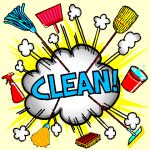Too Clean For Your Own Good?

Too Clean For Your On Good?
Is it possible to be too clean for your own good? With summer 2016 being estimate to be the hottest on record, you would think people would be ecstatic. However, people with allergies may not share the enthusiasm. There is a new mix of ‘super allergens’ which are a combination of increased air pollution and potent irritants gathering in our homes.
The last two decades have introduced an allergy explosion as a result of increased number of hay fever sufferers. In May Dr. Leo Galland, a global expert in the treatment of allergies is set to release a book outlining the reasons for the allergy explosion, which sets out ways to alleviate the effects. Here are a few tips on what you can do to reduce allergy symptoms.
1. Avoid foods that might trigger your hayfever
There are a few proven remedies for hay fever other than over the counter medications. People constantly using antihistamines, yet diet can be just as effective. People with allergies to pollen may experience worse allergies when they eat the food that contains the pollen to which they are allergic. For example, those with an allergy to birch may find they are sensitive to eating apples, carrots hazelnuts and oranges.
2. Try honey
In his book, Dr. Galland talks about how researches in Finland have found that those with a birch allergy who exposed themselves to birch pollen honey daily from November to March reported a 60 percent reduction in allergy symptoms in spring.
3. Eat more Glutathione
Glutathione is an antioxidant that researchers say could be important for people with nasal allergies and sinus problems. Glutathione can be found in foods like asparagus, spinach and garlic.
Not only do the super allergies pose an issues, but so do the super irritants within your home. Reports indicate that indoor air pollution is not only related to severe allergies, but to miscarriage and stroke as well.
The Royal College of Physicians (RCP) also advises that air fresheners and cleaning products emit Volatile Organic Compounds (VOCs) which evaporate into the air and cause allergic reactions.
The information provided by Dr. Galland and the RCP also highlight the dangers of Formaldehyde in our furnishings and laminates. So here are a few tips on reducing indoor air pollutants.
1. Keep Humidity below 50 percent
Mold grows fast in a climate with humidity of 70 percent or higher. Ideal humidity in your home is between 35% and 45 %. While newer homes are being built with humidity controls, a dehumidifier can definitely be of assistance.
2. Stick to floorboards
Studies have found a direct link to formaldehyde in indoor air the likelihood that children growing up in these home will become allergic. With the major sources being pressed wood, particle board and other processed wood products. Sticking to floorboards and choosing formaldehyde free Do – It- Yourself materials and floorings is a great idea on how to avoid exposure.
3. Live low chemical
Cleaning chemicals and air fresheners emit VOC’s, which can cause irritation. Specifically, potent allergens such as sodium lauryl sulphate(a chemical found in shampoos) and triclosan ( a chemical found in hand sanitizers) also kill the good bacteria your immune system needs. It is recommended that you use hot water and a little baking soda for household cleaning.
While we can never completely e rid of allergens and chemicals. Following these helpful tips can definitely help us towards a less clean more allergy free life.


Follow Us!